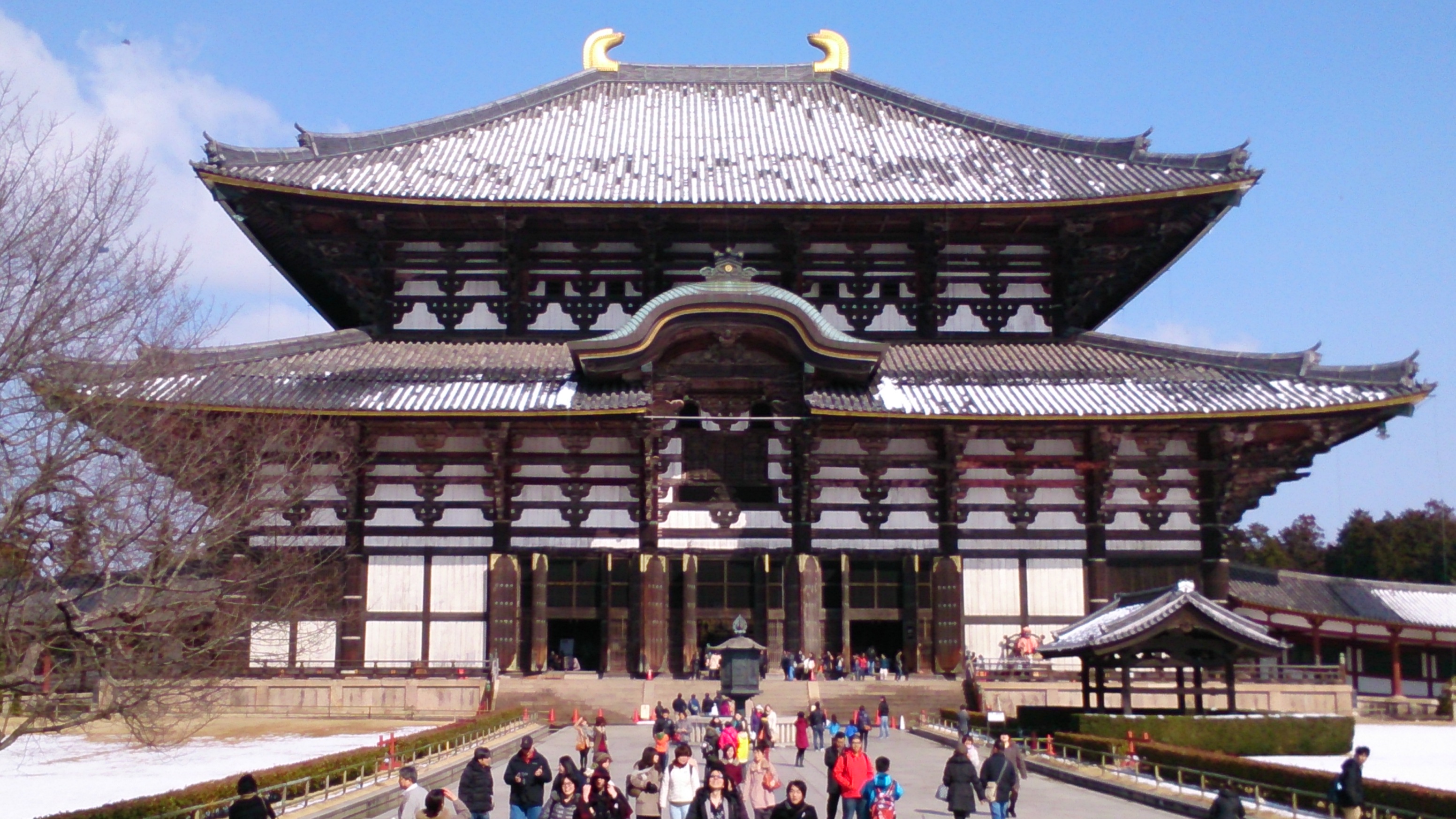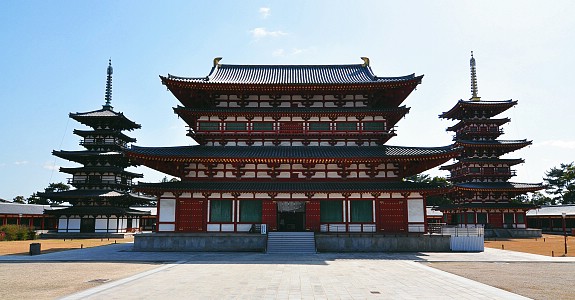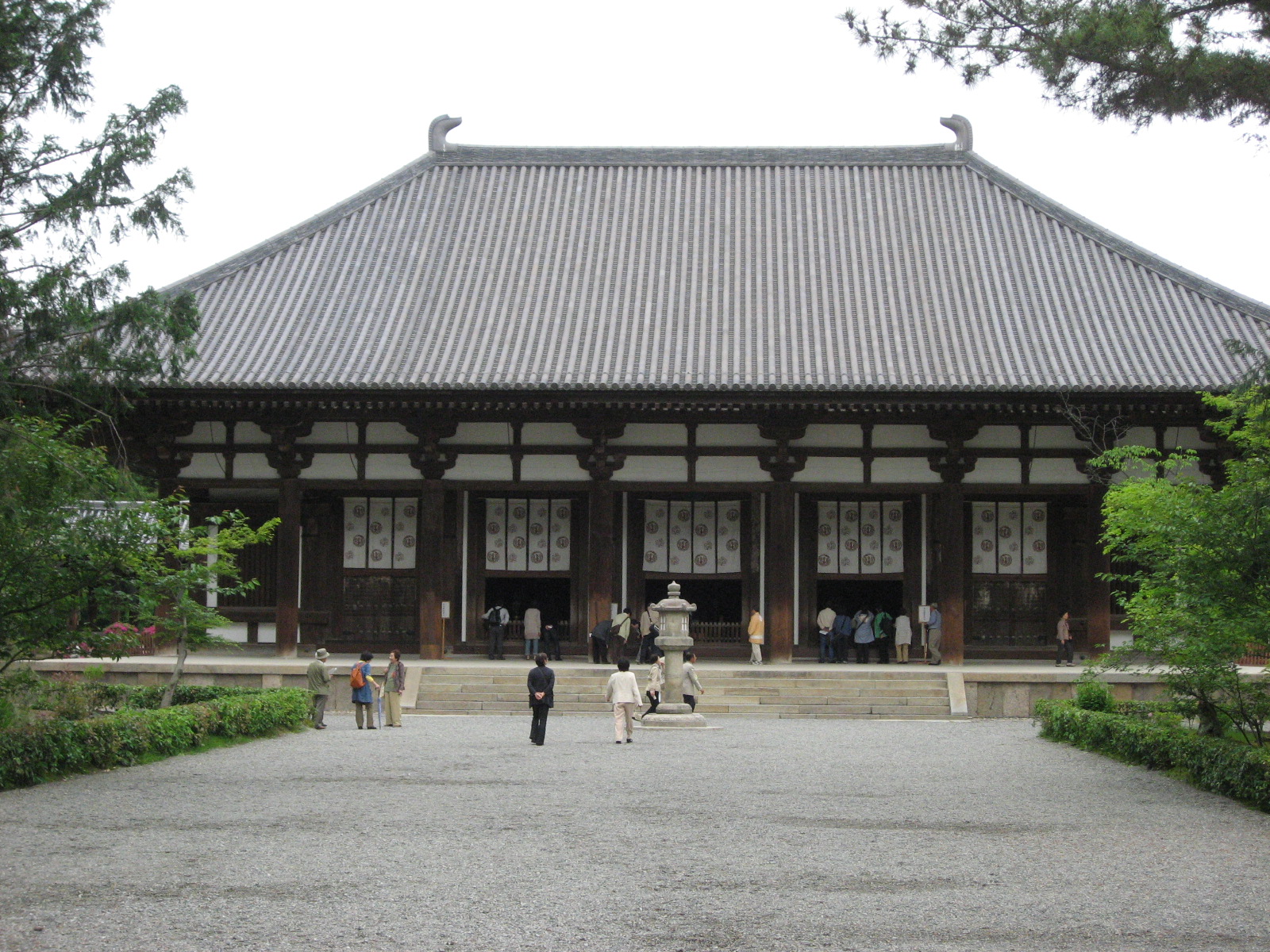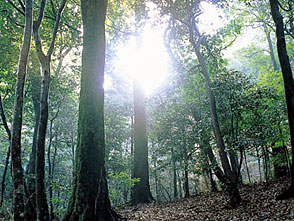Nara Guide Volunteers
Welcome to Nara Guide Volunteers,
a non profit's website for international visitors to Ancient Nara!
Todaiji Temple and Great Buddha

Todaiji (Great Eastern Temple) is one of Japan's most famous and historically significant temples and a landmark of Nara. The temple was constructed in 752 as the head temple of all provincial Buddhist temples of Japan and grew so powerful that the capital was moved from Nara to Nagaoka in 784 in order to lower the temple's influence on government affairs.
Todaiji's main hall, the Daibutsuden (Big Buddha Hall) is the world's largest wooden building, despite the fact that the present reconstruction of 1692 is only two thirds of the original temple hall's size. The massive building houses one of Japan's largest bronze statues of Buddha (Daibutsu). The 15 meters tall, seated Buddha represents Vairocana and is flanked by two Bodhisattvas. For further information, click Todaiji/japan-guide.com
.How to get there
Todaiji is located in the northern part of Nara Park. It is about a 30 minute walk from Kintetsu Nara Station, or about a 45 minute walk from JR Nara Station. It can also be reached by bus from either station. Get off at Todaiji Daibutsuden from where it is a 5-10 minute walk to Todaiji's main building.
Kasuga Grand Shrine
Kasuga Taisha is Nara's most celebrated shrine. It was established at the same time as the capital and is dedicated to the deity responsible for the protection of the city. Kasuga Taisha was also the tutelary shrine of the Fujiwara, Japan's most powerful family clan during most of the Nara and Heian Periods. Like the Ise Shrines, Kasuga Taisha had been periodically rebuilt every 20 years for many centuries. In the case of Kasuga Taisha, however, the custom was discontinued at the end of the Edo Period.
Beyond the shrine's offering hall, which can be visited free of charge, there is a paid inner area which provides a closer view of the shrine's inner buildings. Furthest in is the main sanctuary, containing multiple shrine buildings that display the distinctive Kasuga style of shrine architecture, characterized by a sloping roof extending over the front of the building. For further information, click Kasuga Grand Shrine/japan-guide.com.
How to get thereKasuga Taisha is located in the east of Nara Park. It is about a 30 minute walk from Kintetsu Nara Station, or a 45 minute walk from JR Nara Station. Alternatively, it can be reached by bus from either station. Get off at the Kasuga Taisha Honden bus stop (200 yen, frequent departures).
Kofukuji Temple
Kofukuji used to be the family temple of the Fujiwara, the most powerful family clan during much of the Nara and Heian Periods. The temple was established in Nara at the same time as the capital in 710. At the height of Fujiwara power, the temple consisted of over 150 buildings. Today a couple of buildings of great historic value remain, including a five story pagoda and a three story pagoda. At 50 meters, the five story pagoda is Japan's second tallest, just seven meters shorter than the five story pagoda at Kyoto's Toji Temple. Kofukuji's pagoda is both a landmark and symbol of Nara. It was first built in 730, and was most recently rebuilt in 1426. For further information, click Kofukuji/japan-guide.com.
Heijo Imperial Palace Site (Ancient Imperial Palace Site)
During most of the Nara Period (710-794), Nara served as the capital of Japan and was known as Heijo-kyo. The Heijo Palace extended about one kilometer wide and one kilometer long and served as the site of the emperor's residence and the government offices. For its great historical and cultural importance, the palace site is included as one of the UNESCO World Heritage Sites of Nara.
Although the palace once stood as the majestic center of the ancient capital, all of its buildings were eventually lost with the exception of a single hall that now stands at Toshodaiji Temple. When the capital was moved away from Heijo-kyo in 784, Heijo Palace and a large part of the city were abandoned as people flocked to the new capital. The temples on the outskirts of the former capital, however, retained their importance, and the city of Nara eventually resumed its growth around these temples, while the palace grounds were used for nothing but rice fields. For further information, click Heijo Imperial Palace/japan-guide.com.
How to get there
Heijo Palace is located a 15 minute walk east from Yamato-Saidaiji Station,
which can be easily reached from Kintetsu Nara Station by Kintetsu trains
(5 minutes, 200 yen, frequent departures).
Alternatively, the palace grounds can be reached by buses bound for Yamato-Saidaiji Station from both JR Nara Station (about 20 minutes, about 250 yen, every 30 minutes) and Kintetsu Nara Station (about 15 minutes, about 250 yen, every 30 minutes). The Excavation Site Exhibition Hall is located near Heijokyuseki bus stop, the Imperial Audience Hall is located near Sakicho bus stop, and the Nara Palace Site Museum is located near Nijocho bus stop.
Yakushiji Temple

Yakushiji was constructed by Emperor Tenmu in the late 7th century for the recovery of the emperor's sick wife. One of Japan's oldest temples, Yakushiji has a strictly symmetric layout, with the main and lecture halls standing on a central axis, flanked by two pagodas. The main hall was rebuilt in the 1970s after being destroyed by fire, and houses a Yakushi trinity, a masterpiece of Japanese Buddhist art. The East Pagoda is the temple's only structure to have survived the many fires and dates from 730. It appears to have six stories, but is in fact three storied, like the West Pagoda. For further information, click Yakushiji/japan-guide.com.
Toshodaiji Temple

Toshodaiji was founded in the year 759 by Ganjin, a Chinese priest who was invited to Japan by the emperor in order to train priests and improve Japanese Buddhism. "Toshodai" is Japanese for "invited from Tang China", which refers to Ganjin. His influence in the introduction of Buddhism to Japan was monumental, and his arrival and teaching at Toshodaiji were important stages in that process. Toshodaiji's main hall (kondo) was re-opened in late 2009 after being renovated over a period of almost ten years, during which the building was dismantled and reconstructed. The temple's lecture hall (kodo) was moved to Toshodaiji from the Nara Imperial Palace, and is now the only surviving building of the former palace. For further information, click Toshodaiji/japan-guide.com.
Kasugayama Primeval Forest

Kasugayama Primeval Forest contains 175 kinds of tree including quercus gilva, podocarpus nagi, pieris japonica, Japanese evergreen oaks, cedar, and wild cherry trees. A further 598 types of plant and animal life (such as deer, boars and raccoon dogs), 60 bird types and 180 species of insect (the Panchala ganesa loomisi butterfly but one): coexist in the forest making it a place one can become truly at one with nature. In Kasugayama, the area adjacent to Kasuga Taisha Shrine, hunting and logging have been prohibited since 841AD and as Kasugayama has long been tied to Kasuga Taisha Shrine worship it is regarded as a sacred hill. At the same time its natural resources have been strictly monitored and Kasugayama was designated a Japanese natural monument in 1924. In 1955, it was further designated as a special natural monument. To this end Kasugayama Primeval Forest has been preserved so well that it retains much of the primeval look of Japan's days of old and the combined views of Kasuga Taisha Shrine buildings with the forest as a backdrop has created scenery unchanged since the Nara period. (Cited from Historic Monuments of Ancient Nara, Courtesy of Japan Airlines)
Gangoji Temple
Gangoji Temple is one of Heijokyo's (the former name for Nara) seven main temples and originated as Hokoji Temple, Japan's first Buddhist temple proper in Asuka. When the capital was established in Heijokyo, the temple was moved to this new location and was renamed Gangoji Temple. Enjoying much prosperity during the Nara period, the temple and its grounds fell into disrepair around the middle ages and today it finds itself split into two temples, Gangoji Temple located in Chuin-cho, Nara City, and a second temple by the same name in Shibanoshin-ya-cho, also in Nara City. Gangoji Temple (Gokurakubo) in Chuin-cho is itself designated as a World Heritage Site and became popular among commoners following the middle ages of Japanese history. Its Hondo (Main Hall) and Zenshitsu (Zen Room) are reconstructions completed in the Kamakura period and today the Hondo and Zenshitsu of Gangoji Temple in Chuin-cho are ranked as national treasures. (Cited from Historic Monuments of Ancient Nara, Courtesy of Japan Airlines) Gangoji Temple was one of Nara's seven great temples along with Todaiji, Yakushiji, Saidaiji, Kofukuji, Horyuji and Daianji. It originated as Asukadera in Asuka and was moved to Nara in 718. Asukadera is considered Japan's oldest temple. Today, Gangoji is only a small fraction of what it used to be.